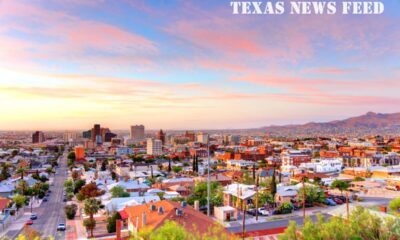Texas News
As Texas swelters, crops and cattle are increasingly at risk
As Texas swelters, crops and cattle are increasingly at risk
“As Texas swelters, crops and cattle are increasingly at risk” was first published by The Texas Tribune, a nonprofit, nonpartisan media organization that informs Texans — and engages with them — about public policy, politics, government and statewide issues.
Sign up for The Brief, The Texas Tribune's daily newsletter that keeps readers up to speed on the most essential Texas news.
LUBBOCK — May brought an unusual sight to the arid High Plains — rain, and lots of it.
Parched lands that previously begged for water welcomed the downpour. Farmers, who were still recovering from the drought-ridden season before, could finally sigh in relief.
Then came the cruel irony — the rain didn't stop for weeks. The same water people prayed for all year was now flooding farmers out of their fields and stopping them from planting their crops on time.
Now, as the entire state sees blazing temperatures that only keep climbing, farmers are questioning if the whiplash-inducing weather will lead to another busted year.
“We're better than we were last year because of the rainfall,” said Calvin Trostle, an agronomist with Texas A&M AgriLife Extension in Lubbock. “The question now is what will our rainfall look like the rest of the year? That could make or break a lot of crops.”
The heat has been unrelenting across the state. Last month, there were an unusually high number of days when temperatures were above 100 degrees. This month, El Paso has set seven new daily heat records and is on pace for its warmest month ever on record, according to the National Oceanic and Atmospheric Administration.
What's going on in the High Plains is just as strange. The astounding amount of rain — 200% of the normal rainfall in the Panhandle and 130% in the Lubbock area — helped keep the region slightly cooler than the rest of the state at the start of the summer. The current U.S. Drought Monitor shows most of the region is clear from drought. But sweltering heat waves are sapping the moisture from the ground.
“Unless some rainfall appears soon, these high-temperature anomalies will increase through the end of July,” said Victor Murphy, climate service program manager with the National Weather Service.
This would be devastating for the High Plains. The region's economy took a big hit last year when the drought caused billions of dollars in losses, which has pushed farmers to lobby for additional disaster assistance in the 2023 Farm Bill. With Farm Bill discussions underway, Sen. John Cornyn visited Lubbock to talk about the high-stakes legislation that pays for crop insurance as well as the USDA's rural development programs and the nation's food subsidy program known as SNAP. The massive legislation is projected to reach $1 trillion.
Garrett Couts with the Lubbock Chamber of Commerce emphasized how important agriculture is to the region that sits right below the Texas Panhandle. In Lubbock County, there are more than 1,000 farms and 530,000 acres of farmland that people depend on.
“Everybody and every single industry on the South Plains, even if it isn't directly involved in agriculture, is most certainly impacted by it,” said Couts, the agriculture committee chair for the chamber who has worked on a Farm Bill before.
Cotton is the backbone of agriculture in the High Plains region and supplies 30% of the nation's cotton, but it has not been spared from the unhinged Texas weather. After the pressure of the insurance deadline forced many cotton producers to plant late, the crop is now dependent on the rain from a month ago to bloom in the peak of the summer.
“All the fields behind me are yet to bloom and once we go into that, your water use increases dramatically,” said Mark Brown, director of field services for Plains Cotton Growers. “Cotton can sit there and hang on until the rainfall, but if it waits too long then the potential of the crop is limited.”
There are also concerns about how crops and livestock aren't getting relief from the heat at night. According to Murphy with NWS, the average low nighttime temperature for Lubbock this month has been 71.2 degrees Fahrenheit, about 2.4 degrees warmer than normal, making it the ninth-warmest period on record.
This is a warming trend seen nationwide. In the last 30 days, there have been more than 2,800 times a city or town's coolest nighttime temperature was hotter than previous records. During the same time, NOAA found about 683 times when the hottest nighttime temperature was cooler.
Murphy said this ratio has been consistent over two decades.
“One of the prevailing wisdoms with climate change is that the biggest impact, at least initially, will be felt in warmer nighttime temperatures,” Murphy said. “It's especially difficult on cattle and livestock, they have a difficult time cooling off at night.”
Murphy said the onset of the U.S. summer monsoon season usually occurs in mid-July, which typically ends extremely hot temperatures, but there are no signs of this happening through Aug. 1. According to a NOAA outlook, the abnormally hot days are going to continue across the U.S for the rest of the month.
Data from NOAA shows there are low chances for rain through the end of July, but the rain that did fall last month is helping for now because it's stored in the soil. Trostle with A&M AgriLife likened soil to a reservoir, saying its ability to hold water is strong but can only withstand so much.
“The soil can be full of water or empty,” Trostle said. “If it's running low and not getting refilled, it can't sustain those plants on a hot day.”
Trostle said an important management strategy in the future might be changing when crops are planted as a way to avoid exposing crops to the extremes of summer heat. He has seen this be an effective strategy for some corn and sorghum farmers in Central Texas.
“If climate change becomes an issue that does begin to affect planting decisions, then it's possible going forward we could see farmers plant a crop a week earlier than they would have in the last decade,” Trostle explained.
Until then, he said, crops will continue to be vulnerable to whatever Mother Nature throws at the farmers who manage them.
“It's like a person, we know what it feels like to be sapped by walking outdoors into a furnace, and we need to eat and drink water to maintain the status quo,” Trostle said. “But crops don't get a choice to turn on the AC or get a drink — they're stuck with whatever's available.”
The deadline for the Farm Bill is Sept. 30, though Cornyn said at the Lubbock event that his colleagues are indicating they may need more time. Cornyn said crop insurance funding is one of his priorities for the legislation.
“We know Mother Nature can be fickle, and so many of these folks depend on that safety net,” Cornyn said. “It's a high-risk proposition in any event, but it just makes things more difficult when you don't have that safety net.”
Disclosure: Texas A&M AgriLife and Plains Cotton Growers have been a financial supporter of The Texas Tribune, a nonprofit, nonpartisan news organization that is funded in part by donations from members, foundations and corporate sponsors. Financial supporters play no role in the Tribune's journalism. Find a complete list of them here.
Join us for conversations that matter with newly announced speakers at the 2023 Texas Tribune Festival, in downtown Austin from Sept. 21-23.
This article originally appeared in The Texas Tribune at https://www.texastribune.org/2023/07/24/heat-texas-agriculture-cattle-climate-change/.
The Texas Tribune is a member-supported, nonpartisan newsroom informing and engaging Texans on state politics and policy. Learn more at texastribune.org.
Did you miss our previous article…
https://www.galvestontrendingnews.com/?p=7544
Texas News
One year later: APD asks for tips in 2022 murder case. Has it been solved?
SUMMARY: The family of D'andre Day is enduring prolonged grief and fatigue as the investigation into his unsolved 2022 murder drags on. Day, 27, was fatally stabbed at East Sixth and Brazos streets on September 4, 2022. Despite Austin Police Department's (APD) efforts and public appeals for tips, no arrests have been made. Surveillance footage showed three men confronting Day and a friend, leading to the deadly altercation. APD and Day's family continue to seek public assistance. Day's uncle expressed ongoing sorrow and hope for justice, urging anyone with information to contact APD's homicide tip line, with a $1,000 reward available through Crime Stoppers.
The post One year later: APD asks for tips in 2022 murder case. Has it been solved? appeared first on www.kxan.com
Texas News
Caitlin Clark records first triple-double by WNBA rookie in Indiana Fever win to rally past New York Liberty
SUMMARY: Caitlin Clark achieved the first triple-double by a rookie in WNBA history, leading the Indiana Fever to an 83-78 victory over the New York Liberty, ending a nine-game losing streak against them. Clark recorded 19 points, 13 assists, and 12 rebounds. Coach Christie Sides praised Clark’s performance and the team’s strong fourth-quarter defense. Key contributions also came from Aliyah Boston, Kelsey Mitchell, and NaLyssa Smith. Despite standout efforts from New York’s Sabrina Ionescu, Betnijah Laney-Hamilton, Breanna Stewart, and Jonquel Jones, the Fever managed to hold off the Liberty to secure the win.
The post Caitlin Clark records first triple-double by WNBA rookie in Indiana Fever win to rally past New York Liberty appeared first on abc13.com
Texas News
‘Firecracker Open’ shows off new improvements to Lions Municipal Golf Course
SUMMARY: Afternoon rains on Saturday paused play at the 2024 Firecracker Open in Austin, held at Lions Municipal Golf Course. Despite the weather, many attended the annual event. The rain benefited the newly laid grass on the upgraded 8,000-square-foot putting green, an improvement over the previous 1,500-square-foot green. These updates are part of several enhancements to the historic course. Scotty Sayers, co-chair of The Muny Conservancy, highlighted the course's popularity, noting it serves as the home course for 12 high school teams. The three-day tournament will conclude on Sunday afternoon.
The post ‘Firecracker Open' shows off new improvements to Lions Municipal Golf Course appeared first on www.kxan.com
-
Texas News5 days ago
I-10 westbound from Beaumont to Houston reopens day after large crack prompted closure at Washington Boulevard
-
Texas News6 days ago
Body found below North State Highway 3 bridge, family used Find My Friends app to find him, League City PD says
-
Podcasts5 days ago
CHAD MAULDIN on Being A Talent Cultivator
-
The Center Square5 days ago
U.S. Supreme Court declines to rule whether social media feeds are free speech | National
-
Texas News6 days ago
Train collides with car carrying grandfather, 2 grandchildren on County 236 in Brazoria County, police say
-
Podcasts6 days ago
Talkin’ Texas | Texans at the Olympics, Fresh Water Sharks, and Bats!
-
Local News4 days ago
Man recalls moment he was hit by Galveston PD officer in pool party brawl video
-
Kaiser Health News5 days ago
Pain Doesn’t Belong on a Scale of Zero to 10







































